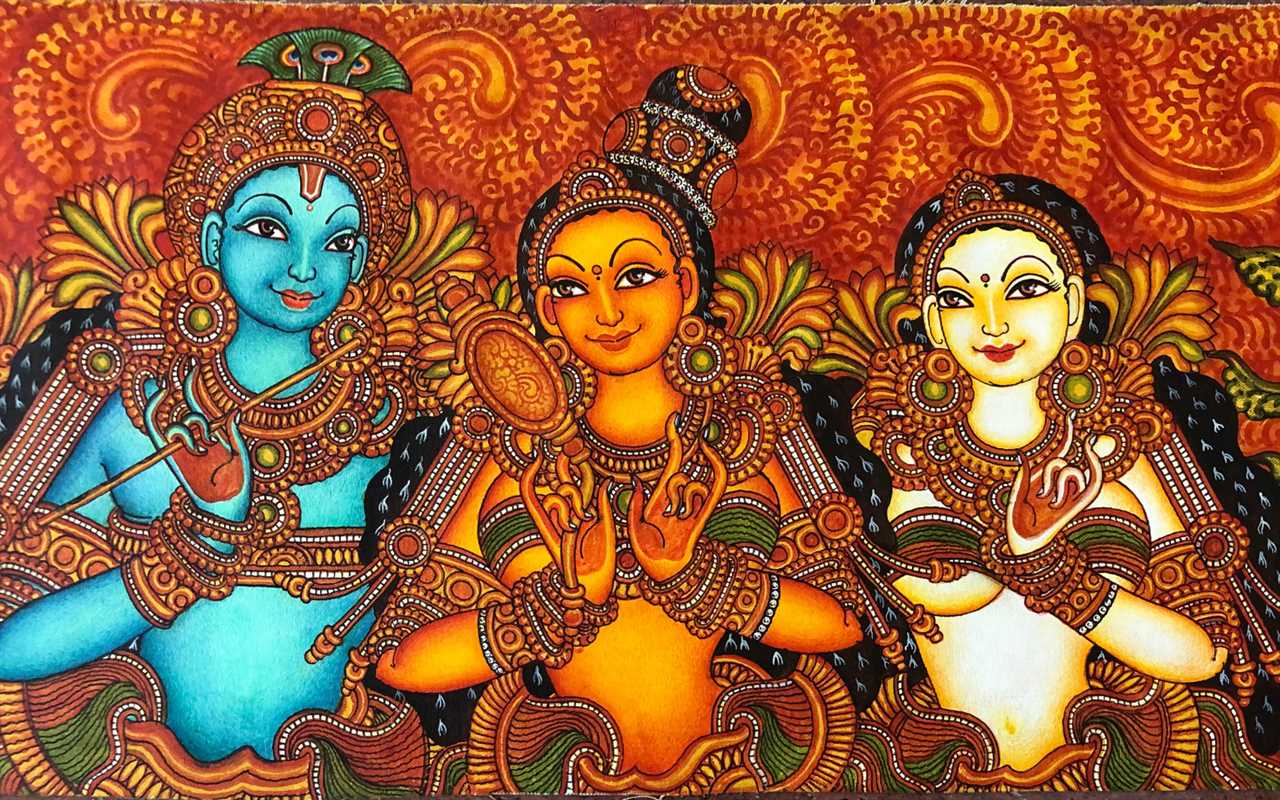
Kerala Traditional Mural Painting is an ancient art form that originated in the southern state of Kerala in India. It is a highly skilled technique that involves painting intricate designs on walls, temples, and other structures.
This art form is deeply rooted in the rich culture and history of Kerala. It is believed to have its origins in the 9th century and has been passed down from generation to generation. The art form flourished under the patronage of the royal families and temples in Kerala.
The paintings are characterized by their vibrant colors, intricate detailing, and elaborate designs. They often depict scenes from Hindu mythology, showcasing gods, goddesses, and epic tales. The artists use natural pigments, made from minerals and plant extracts, to create these mesmerizing paintings.
The techniques used in Kerala Traditional Mural Painting are highly specialized and require years of training and practice to master. The artists use a combination of brushwork and stippling to create the desired effect. They also incorporate elements of perspective and proportion to bring the paintings to life.
Today, Kerala Traditional Mural Painting is not just restricted to temples and historical sites. It has gained recognition as a unique art form and is showcased in art galleries and museums around the world. It continues to be a source of pride for the people of Kerala and is an integral part of their cultural heritage.
Kerala Traditional Mural Painting is an ancient art form that originated in the state of Kerala, India. It has a long and rich history that dates back to the 9th century CE. This unique form of painting was traditionally executed on the walls of temples and palaces.
The origins of Kerala Traditional Mural Painting can be traced back to the Dravidian style of art, which flourished in south India during the ancient period. The art form was heavily influenced by Hindu mythology and religious beliefs. The paintings depicted scenes from Hindu epics such as the Ramayana and Mahabharata, as well as various mythological stories.
Over the centuries, Kerala Traditional Mural Painting evolved and developed its distinct style and techniques. The art form incorporated elements from different artistic traditions, such as the fresco technique and the use of natural pigments.
Unfortunately, Kerala Traditional Mural Painting faced a decline during the colonial period when European painting styles became more popular. However, in recent years, there has been a revival of interest in this traditional art form.
Today, Kerala Traditional Mural Painting is considered a valuable cultural heritage and is preserved and promoted by various art institutions and government organizations. It is admired and appreciated for its intricate details, vibrant colors, and spiritual themes.
Artists from Kerala and around the world continue to practice and learn this ancient art form, keeping the tradition alive. Kerala Traditional Mural Painting has also gained recognition internationally, with artworks being displayed in museums and galleries worldwide.
Characteristics of Kerala Traditional Mural Painting
Kerala Traditional Mural Painting is a unique form of art that originated in the southern state of Kerala, India. It has distinct characteristics that set it apart from other forms of mural painting.
One of the key characteristics of Kerala Traditional Mural Painting is its vibrant colors. Artists use a vivid and rich color palette, which includes shades of red, blue, yellow, green, and gold. These vibrant colors not only enhance the beauty of the artwork but also convey a sense of spirituality and energy.
Another characteristic of Kerala Traditional Mural Painting is its intricate detailing. The artists pay great attention to detail, creating intricate designs and patterns using fine brushwork. From the delicate lines of the facial features to the intricate motifs in the background, every element is carefully executed to create a visually captivating artwork.
Symbolism is another important aspect of Kerala Traditional Mural Painting. The artwork often depicts mythological and religious themes, and each element carries its own symbolic meaning. From the gestures and expressions of the figures to the carefully chosen motifs, every aspect of the painting is imbued with symbolism, allowing viewers to interpret the artwork on a deeper level.
Kerala Traditional Mural Painting also embraces a sense of narrative storytelling. The artwork often depicts scenes from Hindu mythology and legends, narrating stories and conveying moral messages. Each painting tells a story, capturing a significant moment and inviting viewers to enter a world of imagination and intrigue.
The use of natural pigments is another characteristic of Kerala Traditional Mural Painting. Artists create their own pigments by grinding minerals, stones, and plant materials. These natural pigments not only add to the unique charm of the artwork but also ensure its longevity and resistance to fading over time.
There is also a focus on cultural preservation in Kerala Traditional Mural Painting. Artists are trained in traditional painting techniques, ensuring that this ancient art form is passed down from generation to generation. This dedication to preserving the traditional methods and styles makes Kerala Traditional Mural Painting an important part of the cultural heritage of the region.
Influences on Kerala Traditional Mural Painting
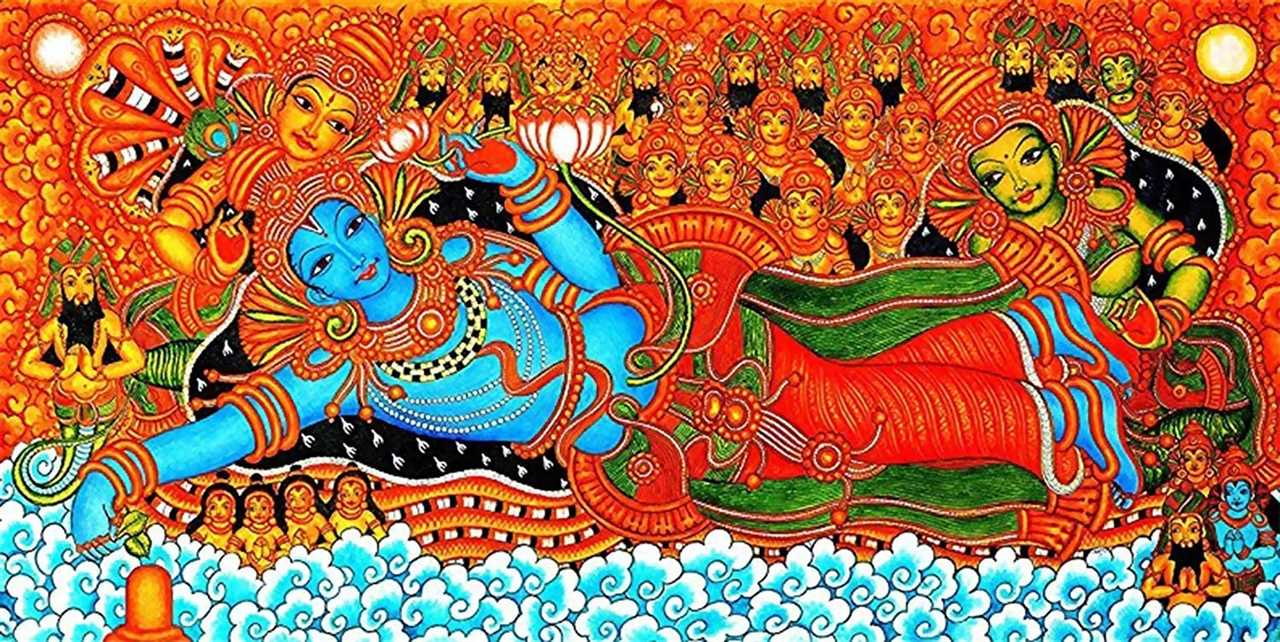
Kerala traditional mural painting is a unique art form that has been influenced by various factors over the centuries. These influences have shaped the subject matter, style, and techniques used in this art form, making it truly distinct and captivating.
Hindu Mythology

One of the most significant influences on Kerala traditional mural painting is Hindu mythology. The art form often depicts stories and characters from Hindu mythology, such as scenes from the Ramayana and Mahabharata. These mythological tales provide a rich source of inspiration for the artists, who bring them to life on the walls of temples and other sacred spaces.
Tanjore Painting
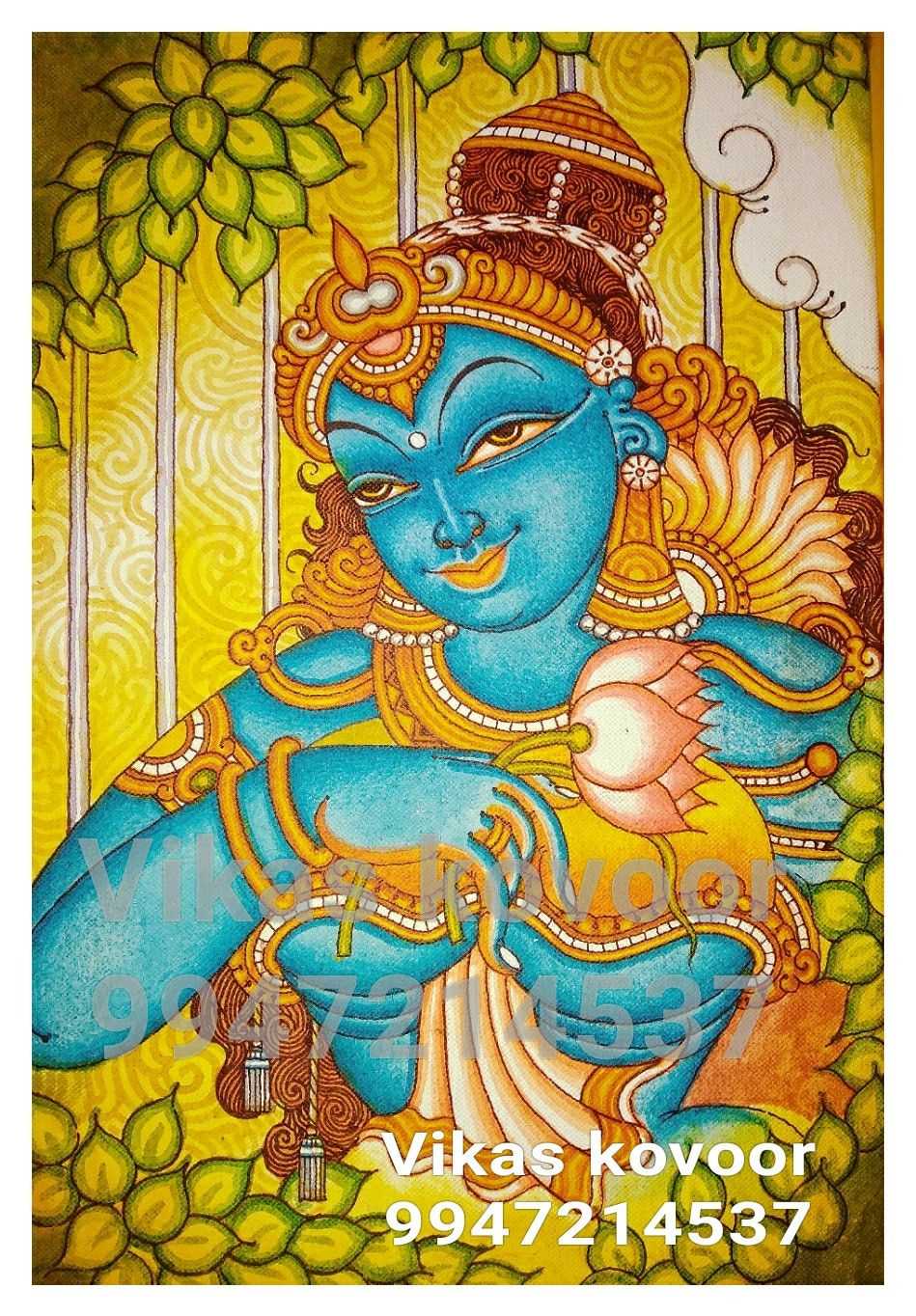
Another influential art form on Kerala traditional mural painting is Tanjore painting. Originating in Tamil Nadu, Tanjore painting is known for its brilliant use of gold foil and vibrant colors. The techniques and aesthetic elements of Tanjore painting have influenced the composition and style of Kerala mural paintings, particularly in terms of the use of bold outlines, bright colors, and intricate details.
| Key Influences on Kerala Traditional Mural Painting |
|---|
| Hindu Mythology |
| Tanjore Painting |
Additionally, the Portuguese influence on Kerala during the colonial era also left its mark on the art form. This can be seen in the introduction of new subject matter, such as Christian themes and Portuguese military figures, in some Kerala mural paintings.
The natural environment of Kerala also plays an important role in influencing this art form. The lush green landscapes, flowing rivers, and abundant flora and fauna of Kerala find their way into the paintings, creating a harmonious blend of nature and culture.
Materials and Techniques Used in Kerala Traditional Mural Painting
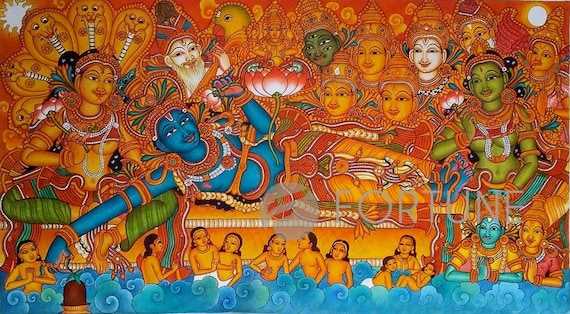
Kerala traditional mural painting is a unique art form that originated in the southern state of Kerala, India. It is known for its vibrant colors and intricate designs. The artists use a variety of materials and techniques to create these beautiful works of art.
Materials:
The primary material used in Kerala traditional mural painting is natural pigments. These pigments are made from various sources such as minerals, plants, and even precious stones. Some commonly used pigments include red ochre, yellow ochre, lamp black, indigo, and gold leaf. These natural pigments give the paintings their distinctive colors and vibrancy.
Another important material used in mural painting is the surface or the canvas. In Kerala traditional mural painting, the canvas is usually a wall or a specially prepared surface made of lime plaster. The lime plaster provides a smooth and durable surface for the paint to adhere to.
Techniques:
The artists use a range of techniques to create Kerala traditional mural paintings. One prominent technique is the fresco technique. In this technique, the pigments are mixed with water and applied to wet lime plaster. As the plaster dries, the pigments become embedded in it, creating a long-lasting and vibrant painting.
Another technique used is the tempera technique. In this technique, the pigments are mixed with a binder, usually egg yolk or glue, to create a thick paste. This paste is then applied to the dry surface and dries to form a hard and durable painting.
The artists also use a technique called outlining, where the outline of the design is first drawn on the surface using charcoal or a pencil. This is followed by filling in the colors and adding details to bring the painting to life.
Subjects and Themes in Kerala Traditional Mural Painting
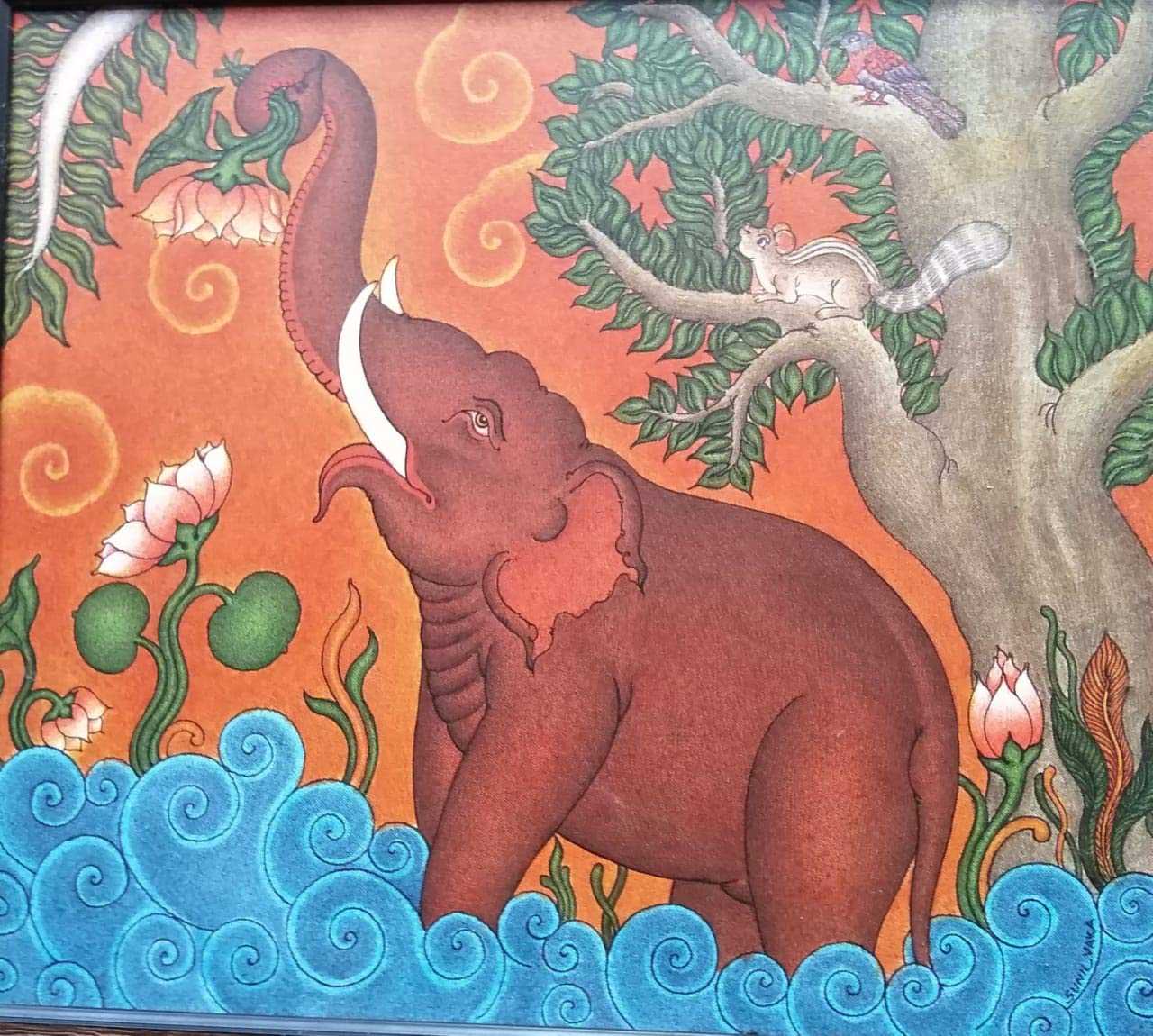
Kerala traditional mural painting is a unique art form that originated in the southern state of Kerala, India. It is known for its vibrant colors and intricate designs, which are typically painted on walls and ceilings of temples and palaces.
Subjects and themes in Kerala traditional mural painting are often inspired by religious and mythological stories. These paintings often depict scenes from Hindu epics such as the Ramayana and the Mahabharata. The artists use their skills to recreate the stories in a visually stunning way, capturing the attention of the viewers.
Some common subjects and themes in Kerala traditional mural paintings include the life of Lord Krishna, Lord Rama’s victory over the demon king Ravana, and the various forms of the Goddess Durga. These themes are often depicted with great attention to detail and symbolism, adding layers of meaning to the artwork.
In addition to religious and mythological subjects, Kerala traditional mural painting also showcases the rich cultural heritage of the region. Paintings depicting traditional dance forms such as Kathakali and Mohiniyattam are also common. The artists capture the grace and intricacy of these dance forms, bringing them to life on the walls.
| Religious and Mythological Subjects | Cultural Subjects |
|---|---|
| Scenes from the Ramayana | Kathakali Dance |
| Scenes from the Mahabharata | Mohiniyattam Dance |
| Life of Lord Krishna | |
| Victory of Lord Rama over Ravana | |
| Forms of the Goddess Durga |
Kerala traditional mural painting is not only a visual delight but also a reflection of the rich cultural and religious heritage of the region. The subjects and themes depicted in these paintings have been passed down through generations, preserving the stories and traditions for future generations to admire and appreciate.
Significance of Kerala Traditional Mural Painting
Kerala Traditional Mural Painting holds immense significance not only as a form of art but also as a reflection of the rich cultural heritage of Kerala, a state in southern India. This ancient art form has been practiced for centuries and continues to be a cherished art form in the region.
Preserving History and Mythology
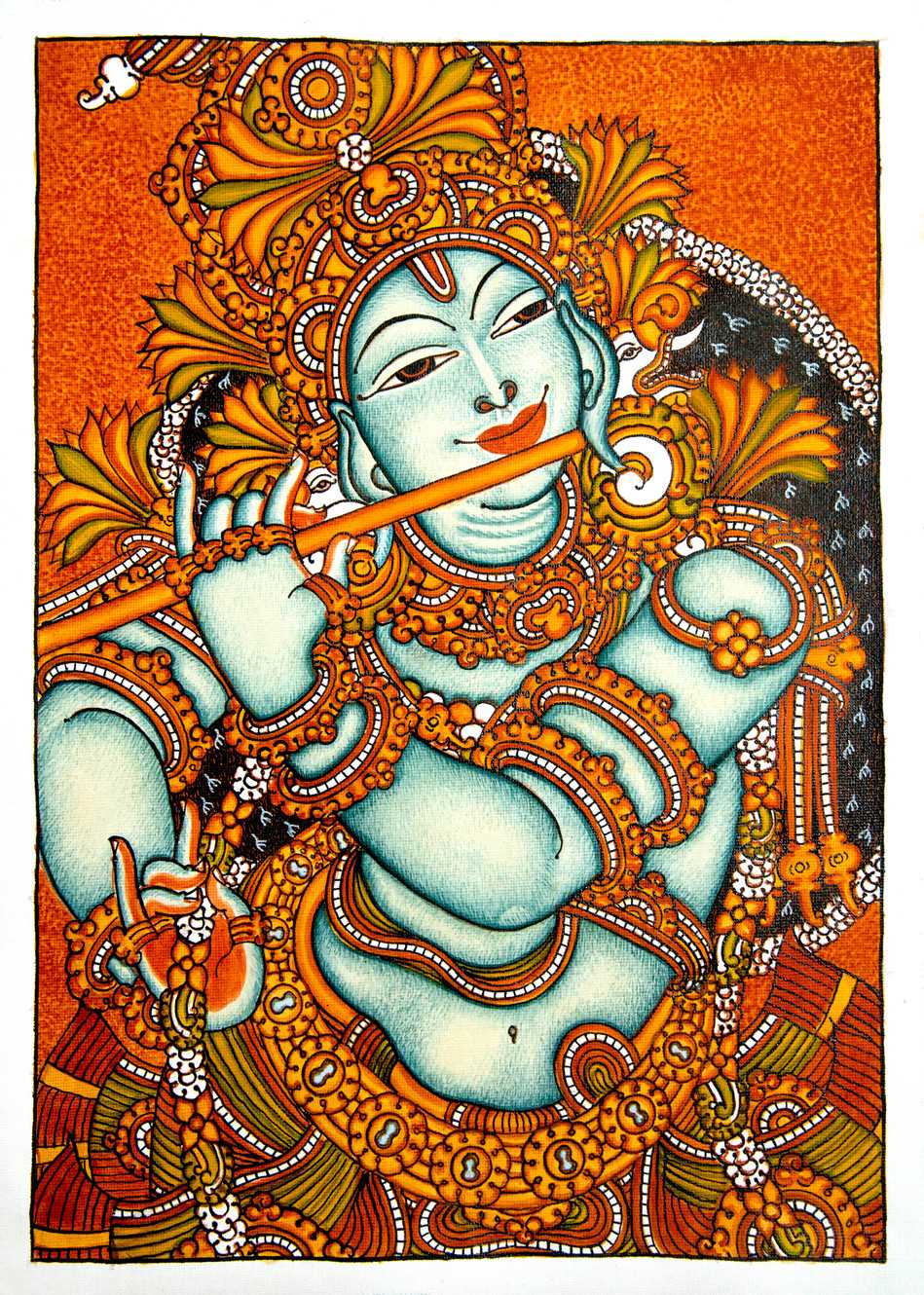
One of the significant aspects of Kerala Traditional Mural Painting is its ability to preserve history and mythology. The murals depict various mythological stories, religious events, and historical events, allowing viewers to understand and appreciate the culture and traditions of Kerala. These paintings serve as visual representations of the rich and diverse heritage of the state.
Spiritual and Religious Significance
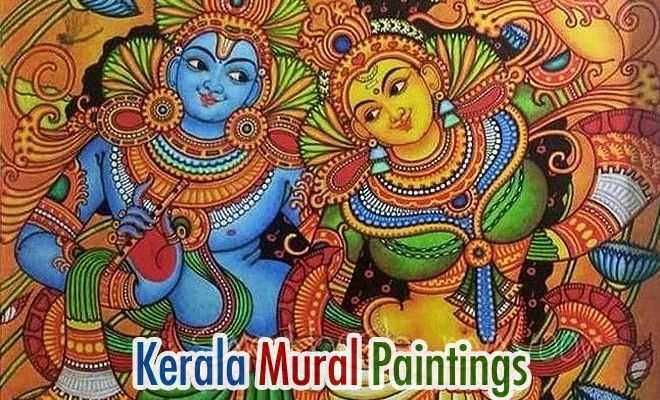
Kerala Traditional Mural Painting also holds great spiritual and religious significance. Many of the murals are found in temples and other religious structures, providing a spiritual ambiance and serving as a medium for religious narratives. These paintings create a sense of divinity and are believed to have a positive influence on the atmosphere and the devotees who visit these sacred spaces.
Furthermore, the meticulous creation of these murals involves religious rituals and strict adherence to traditional techniques, which adds to their spiritual and sacred nature. The use of natural pigments, such as vegetable dyes and mineral powders, further enhances the spiritual aspect of these artworks.
Aesthetic Beauty and Craftsmanship

Kerala Traditional Mural Painting is characterized by its aesthetic beauty and intricate craftsmanship. The artists employ a variety of techniques, such as detailed brushwork and vibrant colors, to bring life to the paintings. The use of gold leaf in certain sections of the murals adds a touch of opulence and grandeur.
The attention to detail and intricate designs in these paintings showcase the skill and expertise of the artists. Each stroke and brushwork is done meticulously, resulting in visually stunning artworks that captivate the viewer. The combination of vibrant colors and intricate details creates a visual feast for the eyes.
Role of Kerala Traditional Mural Painting in Contemporary Art
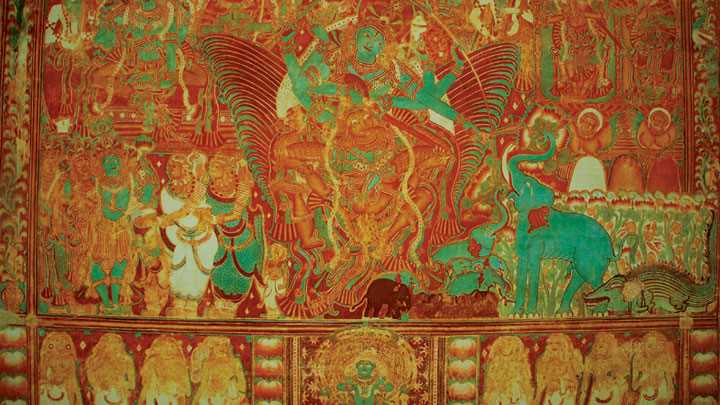
Kerala traditional mural painting has a significant role in contemporary art. With its rich history and cultural significance, this traditional art form has captivated the attention of artists and art enthusiasts alike. Its unique style and techniques have inspired contemporary artists to explore new possibilities and incorporate them into their own works.
Preservation of Cultural Heritage
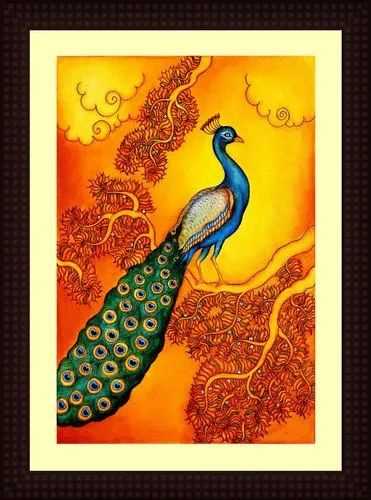
One of the significant roles of Kerala traditional mural painting in contemporary art is the preservation of cultural heritage. This ancient art form has been passed down through generations, and its revival and continued practice contribute to the preservation of traditional techniques, motifs, and stories. By incorporating this art form into their works, contemporary artists help to keep the cultural heritage alive for future generations.
Exploration of Themes and Symbols
Kerala traditional mural painting is known for its depiction of mythological themes and symbols. In contemporary art, artists have taken inspiration from these themes and symbols to explore new concepts and ideas. The intricate detailing and vibrant colors of traditional mural painting provide a unique visual language that artists can adapt and incorporate into their works, creating a fusion of traditional and contemporary elements.
Contemporary artists also use Kerala traditional mural painting as a means of expressing social, political, and environmental issues. By blending traditional techniques and motifs with modern themes, artists bring attention to these pressing matters and create powerful visual narratives.
Moreover, the use of traditional mural painting techniques in contemporary art allows artists to connect with their cultural roots and express their identity. It provides a sense of belonging and heritage, creating a dialogue between the past and the present.
Preservation and Conservation of Kerala Traditional Mural Painting
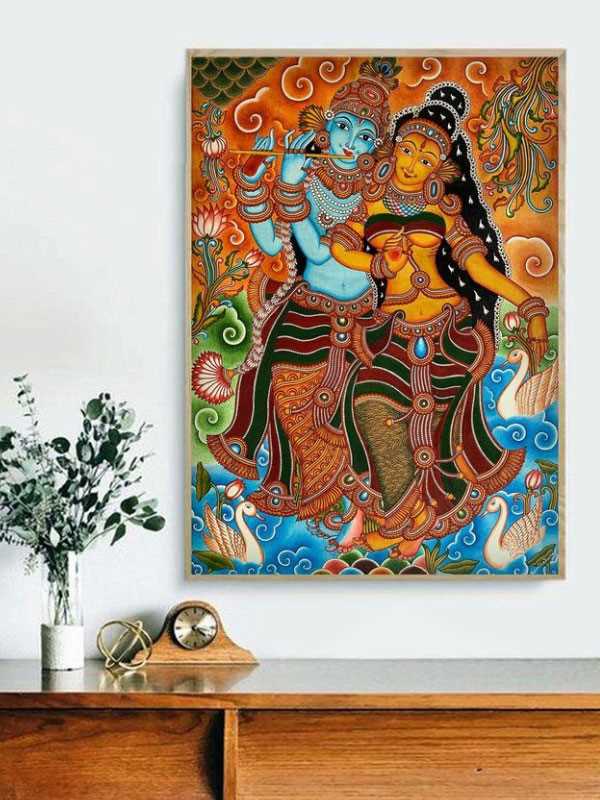
Kerala traditional mural painting is an ancient art form that is deeply rooted in the culture and heritage of Kerala, India. It is a unique style of painting that is known for its intricate designs, vibrant colors, and narrative themes. However, like many traditional art forms, Kerala mural painting is at risk of being lost forever. The preservation and conservation of this art form are of utmost importance to safeguard its cultural significance for future generations.
One of the biggest challenges in preserving Kerala traditional mural paintings is the natural decay and deterioration of the materials used. The paintings are made on walls using natural pigments, such as minerals and vegetable dyes, which are susceptible to damage from moisture, sunlight, and other environmental factors. Therefore, it is crucial to provide proper protection and maintenance to ensure the longevity of these artworks.
Conservation efforts for Kerala mural paintings involve a combination of preventive and remedial measures. One of the key preventive measures is to control the environmental conditions in which the paintings are displayed or stored. This includes regulating temperature, humidity, and light levels to minimize the risk of damage. Additionally, protective coatings can be applied to the paintings to provide an extra layer of defense against external elements.
Another important aspect of preservation is proper documentation and research. Kerala traditional mural paintings often depict religious and mythological stories, and thorough documentation of the narratives and symbolism is essential to preserve their cultural significance. Scholars and experts play a crucial role in researching and interpreting these paintings, helping to unravel the stories they tell and ensuring their historical accuracy.
Training and education are also integral to the preservation and conservation of Kerala mural paintings. It is essential to pass down the knowledge and techniques of this art form to future generations. By training aspiring artists and providing them with the necessary skills and knowledge, we can ensure that the tradition of Kerala mural painting continues to thrive and evolve.
Famous Artists and Artworks in Kerala Traditional Mural Painting
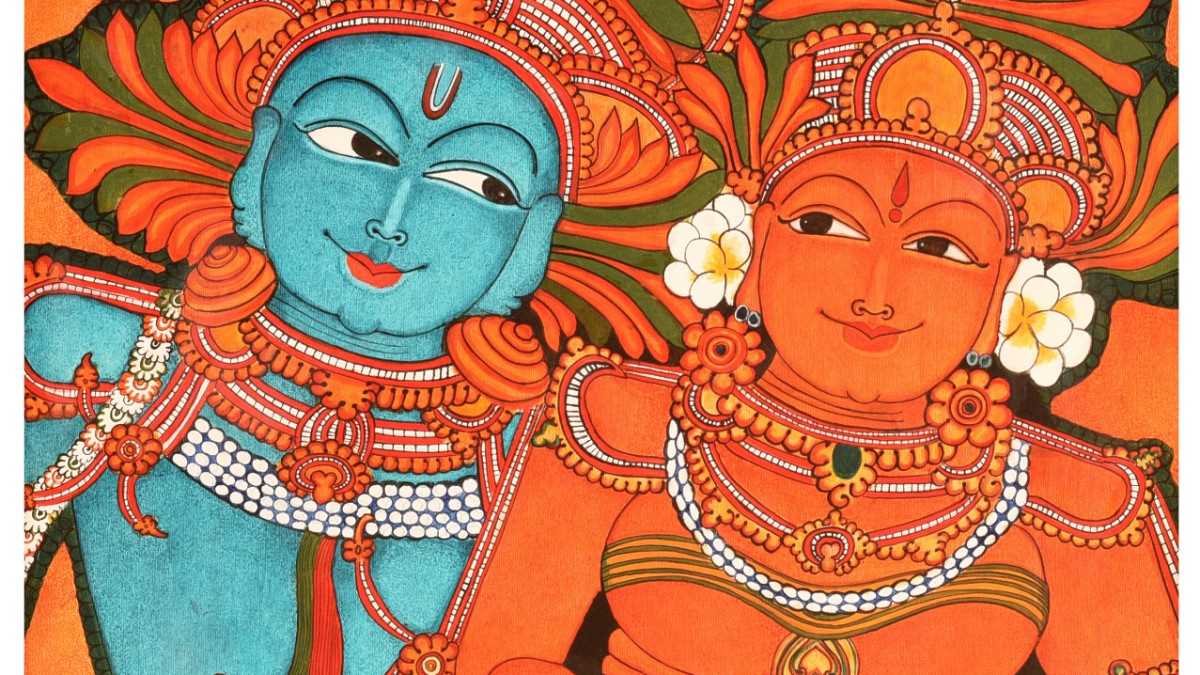
Kerala Traditional Mural Painting is known for its rich history and vibrant artworks. Over the years, many talented artists have emerged in this field, creating marvelous masterpieces that portray the essence of Kerala’s culture and heritage. Here are some of the famous artists and their notable works in Kerala Traditional Mural Painting.
Kunjiraman Narayanan
Mammiyoor Krishnan Kutty Nair
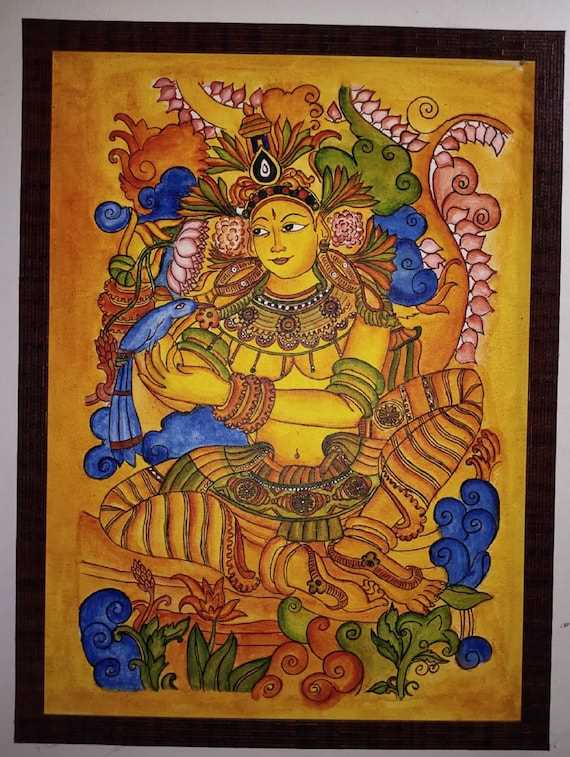
Mammiyoor Krishnan Kutty Nair is another renowned artist in this art form. His works beautifully showcase the rich mythical stories and legends of Kerala. One of his famous artworks is the mural in Mattancherry Palace, depicting the Ramayana epic with stunning attention to detail and artistic finesse.
Another notable artist is Mammiyoor Krishnan Kutty Nair, who is known for his incredible talent in capturing the essence of Kerala’s mythology through his murals. One of his famous works is the mural in the Mattancherry Palace, which depicts the epic story of Ramayana with intricate details and vibrant colors.
Ravivarma Murals
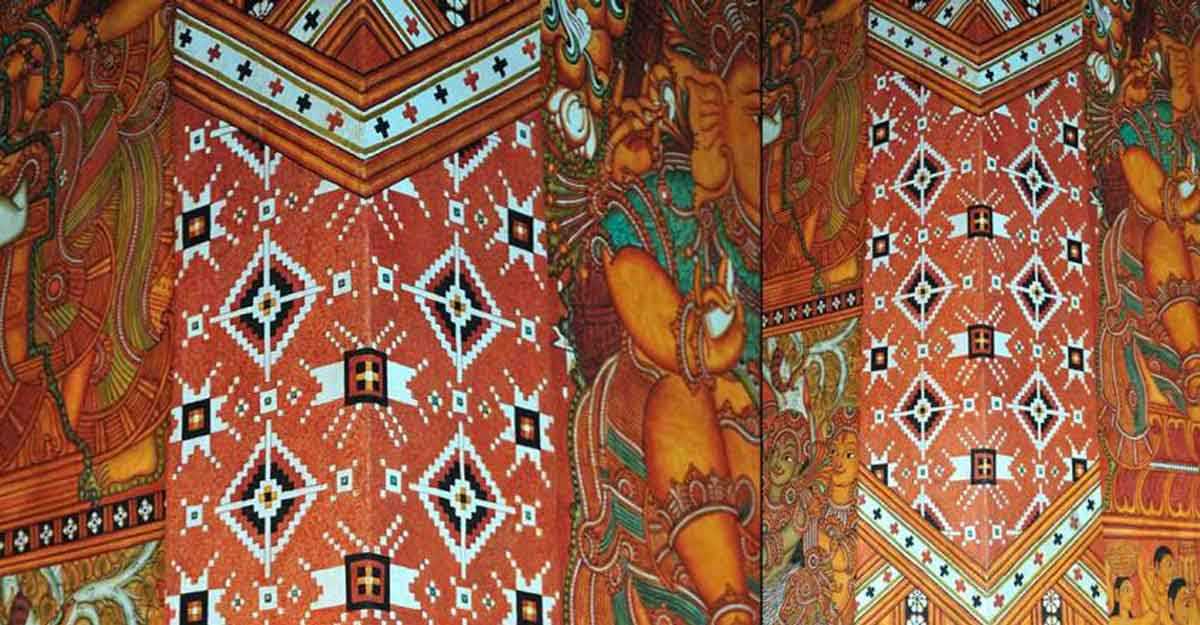
The Ravivarma family has also made a significant contribution to Kerala Traditional Mural Painting. Raja Ravi Varma is a renowned artist who revolutionized the Indian art scene with his fusion of European techniques and Indian subjects. Though not strictly traditional, his works have heavily influenced the Kerala Mural tradition. His famous paintings like “Shakuntala,” “Radha Madhavam,” and “Damyanti & Nala” continue to inspire artists even today.
These artists and their artworks have played a significant role in preserving and promoting Kerala Traditional Mural Painting. With their immense talent and dedication, they have brought these exquisite murals to life, capturing the cultural heritage of Kerala for generations to come.

I am a mural enthusiast and a fervent admirer of street art. Rather than creating murals myself, I am passionate about collecting them. My love for street art knows no bounds. I am dedicated to curating and cherishing these artworks that grace the streets. My collection stands as a testament to my profound appreciation for this form of artistic expression.
read about me



